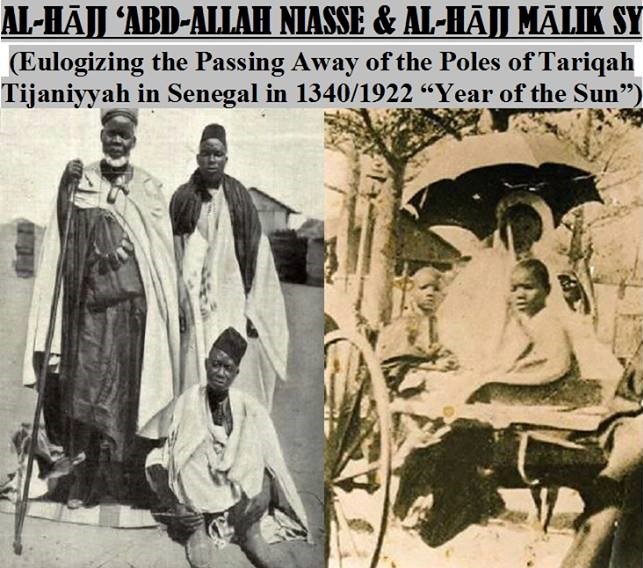
The Most Prominent Religious Leaders in Senegal of the Early Twentieth Century
By: Prof. Rüdiger Seesemann
In: “The Divine Flood: Ibrāhīm Niasse and the Roots of a Twentieth-Century Sufi Revival”
Historically;
ʿAbdallāh Niasse traveled from Gambia to Fez and further to Marseille, accompanied by his eldest son Muḥammad (b. 1299/1881). From there, Muḥammad went to the Ḥijāz to perform the ḥajj, while ʿAbdallāh returned to Morocco where he waited for his son. However, contrary to the claim of most studies, it seems unlikely that they undertook this journey during the early years of the exile. Primary sources suggest that the trip in question took place in 1910-1911, and rather than returning to Gambia, ʿAbdallāh Niasse went to Senegal where he obtained permission to end his exile and take residence in Kaolack.
The favorable response of the colonial administration to Niasse’s request is usually attributed to the intervention of his friend al-Ḥājj Mālik Sy, the most prominent religious leader in Senegal of the early twentieth century together with Niasse and Aḥmadu Bamba, the founder of the Murīdiyya.
Niasse’s first destination coming from Morocco was Tivaouane, the headquarters of the emerging Sy branch of the Tijāniyya, where he spent several weeks as Mālik Sy’s guest.
According to Klein, the latter advised Niasse to write to the governor of Senegal and ask for permission to settle in Kaolack. As Senegalese sources agree, it was thanks to Mālik Sy’s mediation that Niasse was finally allowed to stay in his home country. Within a short period of time, his zāwiya in Kaolack flourished, and the reputation of his school extended well beyond the region of Saloum. Together with Sy, ʿAbdallāh Niasse was the leading figure within the Tijāniyya of Senegal.
Some later voices from Kaolack would even assert that Niasse’s position in the Tijāniyya was superior to Sy’s, as Niasse was the first Senegalese to receive a so-called unlimited license (ijāza muṭlaqa), the highest available rank authorizing the holder to initiate aspirants, appoint deputies without limitation of the number, and give others permission to recite all litanies (awrād, sing. wird), mandatory as well as optional. According to one version that is popular in Kaolack, ʿAbdallāh Niasse, after having obtained his license, tried to convince the Moroccan leaders of the Tijāniyya to issue one for Mālik Sy as well. They finally agreed, though they initially argued that they would usually not bestow such an honor through correspondence. Thus, when Niasse arrived in Tivaouane he was able to confer the license to Sy, on behalf of the Moroccan issuer. This version, however, is rejected in Tivaouane. From their perspective, it was Sy who acted as Niasse’s mentor, as evidenced in Sy’s successful mediation effort.
Although there is much talk about Niasse’s unlimited license, and there is no reason to doubt that he did indeed accede to this rank, it is not quite clear who issued it. During his stay in Morocco in 1910-1911, he met with a large number of leading personalities of the Tijāniyya, including Muḥammad al-Bashīr b. Muḥammad al-Ḥabīb b. Aḥmad al-Tijānī, the oldest living descendant of the order’s founder at the time, who purportedly gave him the original manuscript of Jawāhir al-maʿānī. Other potential issuers of the license include Muḥammad al-Ṭayyib al-Sufyānī, grandson of a companion of Aḥmad al-Tijānī with the same name and longtime head of the zāwiya in Fez; a deputy called al-Muḥibb b. al-ʿArabī; Muḥammad b. Aḥmad al-ʿAbd Lāwī, the son of one of the most eminent disciples of ʿAlī al-Tamāsīnī, al-Tijānī’s first successor; and last not least, Aḥmad b. al-ʿAyyāshi Skīraj (b. 1295/1878; d. 1363/1944), a student of Aḥmad al-ʿAbd Lāwī who was to become the leading scholar of the Tijāniyya in the first half of the twentieth century.
The grandsons of ʿAbdallāh Niasse put much emphasis on the latter connection, although Skīraj, born in 1295/1878, was only in his early thirties and had not risen to his later prominence at the time of his meeting with the Senegalese. Whatever the case, Niasse received licenses from most if not all the personalities mentioned above, and at least one of these was unlimited.
The recognition from the Tijāniyya’s headquarters was a boost to his reputation when he established himself as the foremost scholar of Islam and the Tijāniyya in Saloum and the adjacent regions.
Ibrāhīm Niasse was in his early twenties when ʿAbdallāh Niasse, his great role model, teacher, and initiator passed away on Dhū l-Qaʿda 13, 1340/July 9, 1922, only two weeks after Mālik Sy had died in Tivaouane.
 +221 77 416 53 59 / +221 77 328 30 29
+221 77 416 53 59 / +221 77 328 30 29
 contact@nayloulmaram.com
contact@nayloulmaram.com




